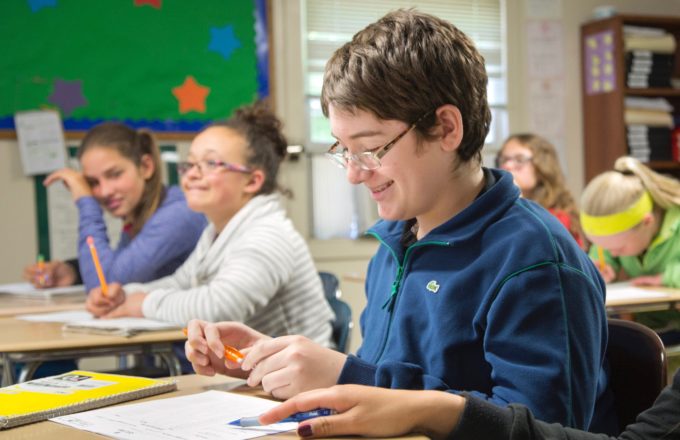This post is part of a series about helping students with LBLD experience academic success.
Read Erin’s other blog posts:
I run a language-based program in central Massachusetts for grades 6-8. This year, there are ten students in my program, and I typically have up to 12 students. Students admitted to the program usually qualify for special education under the category of Specific Learning Disability (SLD) in reading with a cognitive profile of strengths that is consistent with the criteria of dyslexia or, less commonly, under the category of a communication disability.
This is my fifth year teaching in this program, and after attending a Landmark Outreach Summer Institute workshop on Middle School Language-Based Programs given by Ann Larsen several summers ago, I’ve attempted to follow her excellent advice: when building a program, don’t try to introduce too many new practices at once. Instead, focus on one or two new practices or routines you’d like to implement in your program each year and really work on adjusting and adapting them to make them successful in your program. My first year, I was, to be honest, just getting used to the flow of a sub-separate classroom environment where I might have several different grade levels and subjects to teach within one class period. My second year, I focused on organization, adopting Landmark’s Master Notebook system to help my students create binders and folders to organize their materials. My third year, I incorporated the Orton-Gillingham instruction I’d received the previous year into my small-group reading classes, and last year my professional goal involved utilizing a growth mindset approach to my mathematics classes to help improve student perseverance and performance on open-ended math word problems, such as those on the MCAS. For this goal, I relied heavily on Jo Boaler’s excellent book Mathematical Mindsets as well as her website, YouCubed.
This year, equipped with the new edition of Terrill M. Jennings and Charles W. Haynes’s text From Talking to Writing, I decided that my goal would be to improve student writing. Of course, I have always worked on writing in my program. My students use the five-step writing process, they know their way around several different types of graphic organizers meant for different genres of writing. By 8th grade, most can write a decent five-paragraph essay – even those who outright refused to pick up a pencil when they first came to me in sixth grade, who were brought to tears upon hearing the words “write” and “paragraph.” I have seen the power of this writing process – giving students time to brainstorm and develop their ideas, providing predictable steps and supports such as sentence starters when needed, and teaching students to use and eventually create their own graphic organizers – time and time again. Producing essays when given enough time to follow this process is not an issue for my students once they have been with me for a year or two. However, when they are given an on-demand writing task with limited time, such on the MCAS, it becomes painfully obvious that these kids are missing some very basic writing skills and strategies.
Jennings and Haynes advocate starting at the sentence level. This approach may seem counterintuitive given the amount of writing students are expected to produce in middle school, but if there’s one thing I trust when working with the kids who need the most help, it’s that sometimes the only way forward is to go backwards. I recently attended a workshop at the International Dyslexia Association Conference at Foxwoods in October given by Judith Hochman, creator of The Writing Revolution writing program, who spoke about the demands on young students in the area of written language dictated by state standards and high-stakes testing, such as third grade students who haven’t yet mastered sentence structures being asked to write multi-paragraph narrative essays. How can this possibly work for students with language-based learning disabilities, who research shows need highly structured, explicit instruction in the basics of written language in order to be successful?
If you work with students in the LBLD population, you know that these are highly intelligent, creative kids. Coming up with ideas is seldom their problem if they are given a chance to verbally brainstorm or discuss these ideas first. Expressing these ideas in writing, particularly in an on-demand situation, without having the time to process through a prompt first, is where my students really struggle. Like many students with LBLD, my students tend to produce the simplest sentences imaginable and struggle to use more sophisticated sentence structures. (I’m sure I’m not the only one who gets unreasonably excited when I see, for example, a correctly placed comma in students’ writing!) When I think about how I myself learned to write, I know that it wasn’t through specific grammar exercises – it was reading, pure and simple. We often learn to write correctly and creatively by reading, so students who struggle with this task, who do not enjoy it or take it on independently, are at a double disadvantage. I truly believe that it is only by making these tasks fun and engaging that we can convince these students (for whom writing is a task akin to being asked to clean their bathroom floor with a toothbrush – a task which some of my students might prefer!) to try to stretch themselves to write in a different way. After reading my students’ MCAS responses from the previous spring’s assessment, I developed a goal to provide my students with the structures and tools that they need to produce more advanced, more sophisticated written work on demand. In short, I wanted them to be able to express themselves in writing in a way that is more closely reflective of their intelligence and the quality of their ideas.
To assess my students’ current level of performance and get a sense for how they approach and react to writing tasks, I began with a simple self-created writing diagnostic including some basic skills such as punctuation and capitalization, writing basic sentences, and combining sentences. After this step, I reviewed how to change “simple sentences” into “super sentences,” and we completed an introductory activity about expanding sentences using sentence frames and questions (i.e. Where? Why? When?). This process was followed by a review activity about building compound sentences using FANBOYS, as well as writing complex sentences using introductory phrases and clauses. I used pictures to make this activity a little more engaging – my diagnostic packet and other supplementary activities are attached to this blog post for reference. My goal with this activity was to remind students of these sentence structures, which of course they had learned and promptly forgotten about earlier in their school careers! After we had reviewed these structures, I had my students complete an activity where they cut out a series of independent clauses, as well as a handful of commas and FANBOYS, and practiced building compound sentences with a partner on their desk. They enjoyed this multi-sensory activity and became more adept at placing the comma correctly and using each conjunction appropriately.
After spending some time reviewing and encouraging my students to “play” with language by writing different types of sentences and using more academic words and clauses and phrases in their writing, it was time to tackle more comprehensive writing skills using one of my students’ very favorite units. This unit has now become a tradition that I assign every year in the weeks leading up to Halloween: our October scary story contest. This contest will be the topic of part 2 of this blog series on creating positive student outcomes in middle school special education.



